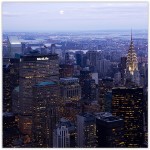 Morningside Heights is a neighborhood of the borough of Manhattan in New York City, on the border of the Upper West Sideand west Harlem. The area is usually described as being on the Upper West Side, but has also been described as part of “Greater Harlem” because of a disputed claim that the Upper West Side goes no farther north than 110th Street. Morningside Heights is bounded by Morningside Park at Morningside Drive to the east, Manhattanville and Harlem at 125th Streetto the north, Manhattan Valley at 110th Street to the south, and Riverside Park at Riverside Drive to the west. The main thoroughfare is Broadway.
Morningside Heights is a neighborhood of the borough of Manhattan in New York City, on the border of the Upper West Sideand west Harlem. The area is usually described as being on the Upper West Side, but has also been described as part of “Greater Harlem” because of a disputed claim that the Upper West Side goes no farther north than 110th Street. Morningside Heights is bounded by Morningside Park at Morningside Drive to the east, Manhattanville and Harlem at 125th Streetto the north, Manhattan Valley at 110th Street to the south, and Riverside Park at Riverside Drive to the west. The main thoroughfare is Broadway.
It is chiefly known as the home of institutions such as Columbia University, Teachers College, Barnard College, the Manhattan School of Music, Bank Street College of Education, “Grant’s Tomb”, Jewish Theological Seminary of America, and Interchurch Center. Because of the number of educational institutions in the neighborhood, its nickname is the Academic Acropolis. However, Morningside Heights also contains the Cathedral of Saint John the Divine, the Riverside Church, the Broadway Presbyterian Church, Union Theological Seminary in the City of New York, and St. Luke’s Hospital.
The neighborhood is part of the Fifteenth Congressional District of New York, which includes all of Upper Manhattan. Traditionally, Morningside Heights has been heavily Democratic, as has much of the city.
HISTORY
In the 17th century, the land that is now Morningside Heights was known as Vandewater’s Heights, named for the landowner. On September 16, 1776, the Battle of Harlem Heights was fought in Morningside Heights, with the most intense fighting occurring in a sloping wheat field that is now the location of Barnard College. A plaque by the Columbia University gate on 117th Street and Broadway commemorates this battle.
Use of the name “Morningside Heights” for the neighborhood arose in the 1890s when development of the area commenced. The name “Bloomingdale” – which referred to part of the present-day neighborhood of Manhattan Valley, located to the south – was also used for the area around the Bloomingdale Insane Asylum, which was located at the present location of the main campus of Columbia University. However, other names such as “Morningside Hill” and “Riverside Heights” were used for the area. No single name was commonly used for the neighborhood by the time Columbia University, Teachers College, the Cathedral of Saint John the Divine, andSt. Luke’s Hospital started construction. Two names eventually gained the most use; “Morningside Heights” was preferred by the two colleges, while “Cathedral Heights” was preferred by St. John’s and St. Luke’s. After about 1898, “Morningside Heights” became the most generally accepted, although the diocese at St. John’s continued to call the neighborhood Cathedral Heights well into the 20th century. The term “Morningside” came from the park on the east flank of the plateau, which was lit up by the rising sun and which was called “Morning Side Park” in 1870 when the city parks commissioner recommended a survey of the land.
In 1947 David Rockefeller became involved in a major middle-income housing development when he was elected as chairman of Morningside Heights Inc. by fourteen major institutions that were based in the area, including Columbia University. In 1951 the organization developed Morningside Gardens, a six-building apartment complex to house middle-income families from all ethnic backgrounds. Morningside Gardens, an experimental co-op project, opened in 1957 between 123rd and LaSalle Streets, Broadway, and Amsterdam Avenue.
The social problems in the area prompted Columbia to purchase much of the neighborhood’s real estate, leading to accusations of forced eviction and gentrification. This process reached its nadir in 1968, when protests erupted in both the neighborhood and on Columbia’s campus over the university’s proposal to build a gym in Morningside Park. Residents alleged that the park’s proposed separate entrance for Harlem residents on the lower level of the park was segregated, and that public park space was being annexed by a wealthy private institution. The university was eventually forced to abandon the plan. However, Columbia University has still expanded its presence in the neighborhood markedly over the last few decades, and gentrification and urban renewal have proceeded apace. In January 2008 the university received approval from the City Council to expand significantly in nearby Manhattanville.
In the last decade, some businesses in the area have started using the name SoHa (or “South of Harlem”) to refer to the neighborhood, as seen in the names of Max’s SoHa restaurant and the former SoHa nightclub in Morningside Heights.
